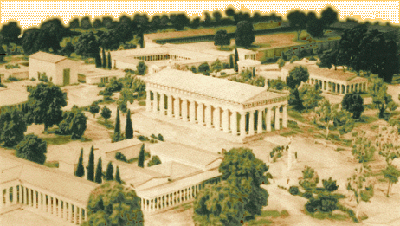This page includes information that may not reflect the current views and values of the Penn Museum.

 The
ancient Olympic Games began in the year 776 BC, when Koroibos, a
cook from the nearby city of Elis, won the stadion
race, a foot race 600 feet long. The stadion track at Olympia is shown here.
According to some literary traditions, this was the only athletic event
of the games for the first 13 Olympic festivals or until 724 BC. From 776
BC, the Games were held in Olympia every four years for almost 12 centuries.
The
ancient Olympic Games began in the year 776 BC, when Koroibos, a
cook from the nearby city of Elis, won the stadion
race, a foot race 600 feet long. The stadion track at Olympia is shown here.
According to some literary traditions, this was the only athletic event
of the games for the first 13 Olympic festivals or until 724 BC. From 776
BC, the Games were held in Olympia every four years for almost 12 centuries.

